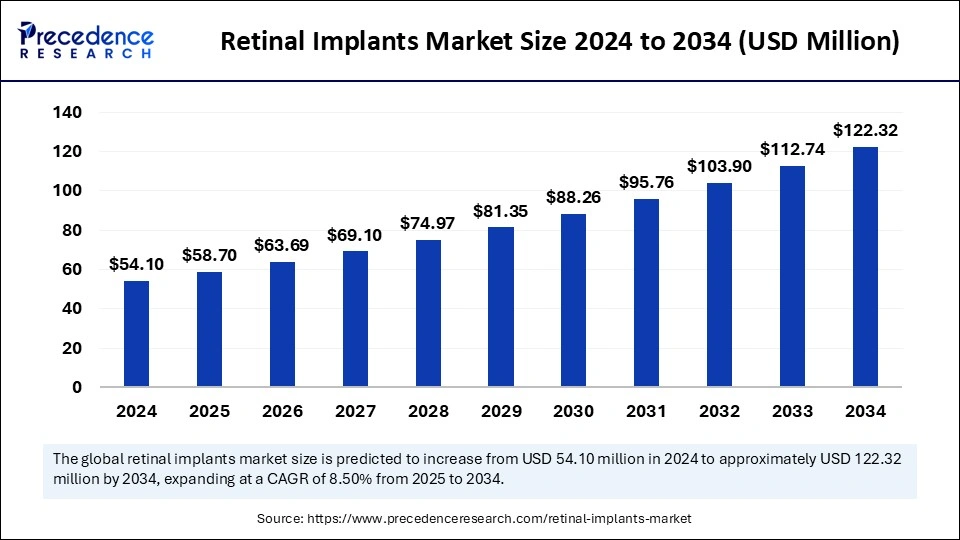The Retinal Implants Market is projected to reach USD 122.32 million by 2034
The retinal implants market, valued at USD 54.10 million in 2024, is expected to expand to around USD 122.32 million by 2034, registering a CAGR of 8.50% from 2025 to 2034.
Retinal Implants Market Key Insights
- North America dominated the market with the largest share of 38% in 2024.
- The Asia Pacific is projected to grow at a solid CAGR of 9.5% between 2025 and 2034.
- By type, the Argus II segment held the biggest market share of 36% in 2024.
- By type, the retina implant alpha AMS segment is anticipated to expand at the highest CAGR over the forecast period of 2025 to 2034.
- By end-user, the hospitals segment contributed the largest market share of 54% in 2024.
- By end-user, the research & manufacturing segment is expected to grow at a notable rate in the coming years.
The retinal implants market is witnessing significant growth, driven by advancements in medical technology and increasing cases of retinal degenerative diseases such as retinitis pigmentosa and age-related macular degeneration (AMD). Retinal implants, also known as bionic eyes, are devices designed to restore partial vision by bypassing damaged photoreceptors and stimulating retinal neurons. These implants are particularly beneficial for individuals with severe vision impairment, offering hope for improved mobility and quality of life. As research and development in the field of neuroprosthetics and artificial vision continue to advance, the market is expected to expand, attracting investments from both medical technology companies and research institutions.
Sample Link: https://www.precedenceresearch.com/sample/5689
Market Drivers
Several key factors are propelling the growth of the retinal implants market
- Rising Prevalence of Retinal Diseases – The increasing number of people affected by retinal degenerative disorders, especially among the aging population, is a primary driver for market growth.
- Advancements in Biomedical Engineering & Artificial Vision – Continuous innovations in neuroprosthetics, microelectronics, and bio-compatible materials have improved the efficiency and longevity of retinal implants.
- Growing Demand for Vision Restoration Solutions – With an increasing focus on improving the quality of life for visually impaired individuals, retinal implants are gaining traction as a viable solution.
- Supportive Government Policies & Funding – Various governments and healthcare organizations are investing in research and offering incentives for the development of retinal prosthetics.
- Rising Awareness & Accessibility – Increasing awareness about bionic eye technology and improving healthcare infrastructure in emerging economies are expanding the market reach.
Opportunities
The retinal implants market presents several promising opportunities
- Technological Innovations in Artificial Vision – The integration of AI and machine learning in retinal implants can enhance image processing and adaptability, leading to better visual restoration outcomes.
- Expansion in Emerging Markets – With increasing healthcare investments and growing awareness, developing countries offer substantial growth opportunities for market expansion.
- Miniaturization & Wireless Implants – Advancements in nanotechnology and wireless power transfer can lead to more compact and efficient retinal implants, improving patient comfort and adoption rates.
- Collaborations & Research Partnerships – Increased collaboration between medical institutions, tech firms, and government agencies can accelerate product development and regulatory approvals.
Challenges
Despite its growth potential, the market faces several challenges
- High Cost of Retinal Implants – The expensive nature of these devices and surgical procedures makes them inaccessible to many patients, limiting widespread adoption.
- Regulatory & Approval Complexities – Stringent regulatory requirements for medical devices can slow down the approval process, delaying market entry for new technologies.
- Limited Efficacy & Adaptability – Current retinal implants provide only partial vision restoration, and their effectiveness varies among patients, posing challenges in achieving consistent results.
- Surgical Risks & Post-Implantation Complications – The implantation procedure is complex and can lead to potential risks such as infections, retinal detachment, or device failure.
Regional Insights
- North America – Leading the global market due to strong R&D investments, advanced healthcare infrastructure, and supportive regulatory frameworks. The U.S. is a key contributor with several pioneering companies and research institutions developing retinal implants.
- Europe – Countries like Germany, the UK, and France are making significant advancements in retinal prosthetics, driven by increasing funding for artificial vision research.
- Asia-Pacific – Expected to witness the fastest growth due to a rising aging population, increasing prevalence of retinal diseases, and improving healthcare access in countries like China, Japan, and India.
- Latin America & Middle East & Africa – While adoption is currently low, improving healthcare systems and increasing awareness about retinal implants may drive future market growth.
Read Also: Healthcare Service Robots Market
Market Companies
Segments Covered in the Report
By Type
- Retina Implant Alpha AMS
- Implantable Miniature Telescope
- Argus II
- Others
By End-user
- Hospitals
- Outpatient Facilities
- Research & Manufacturing
By Region
- North America
- Europe
- Asia Pacific
- Latin America
- Middle East and Africa (MEA)

